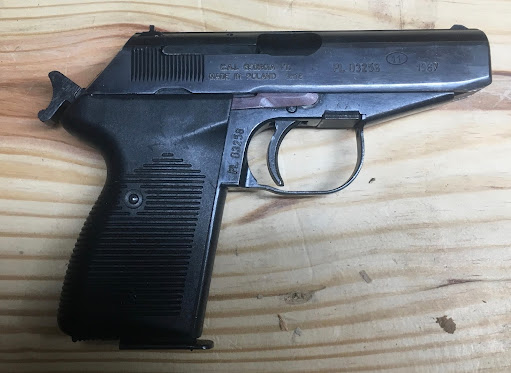There has been a good supply of Polish made P83 pistols in the last year or so, and I've been contemplating getting one as they're very inexpensive- $219 from most distributors. What finally convinced me was the thought that there's not an infinite supply of the out there, and when the current supply runs out (which granted may not be for a while) the price will be going up. Consider that when I bought my 1947 Nagant revolver they could be had as cheaply as $99 from the C&R dealers, and now they sell for $250 to $300. I found mine at Gander Mountain for $229, plus $25 shipping, which is about what would cost if I'd ordered from the distributor and had it shipped to a local FFL.
Mine arrive in well worn but, it appeared, mostly unfired condition. The bore is nice and shiny. There are a lot a shallow scratches but the only appreciable wear to the bluing is right around the muzzle, which is exactly what you expect to see on a gun that has been repeatedly unholstered and reholstered without being fired.
]
So what is a P83?
In 1958 the Poles needed a new sidearm for the police and military, and as a client state of the USSR that meant whatever they chose had to chamber the Soviet standard 9x18 Makarov cartridge. Unlike the Bulgarians and other client states, they didn't license the standard Makarov pistol design. Instead, they designed their own pistol, called the P64. It was a beautiful little pistol, with all machined parts, and it was very expensive to make, so in 1983 they replaced it with the P83.
Like the P64, the P83 is heavily influenced by the design of the Walther PPK. It's a straight blowback design with a fixed barrel that is double action on the first shot, and single action on successive shots. Unlike both the PPK and the P64, the P83 made largely of stamped and welded pieces. It's also significantly larger; take a look at the P38 next to a modern PPK/S in .22:
It may not be as elegant looking at the PPK or the P83, but it's a rugged, reliable pistol. Let's take a closer look at some details.
The magazine release is the typical European heel release. It's easy to operate, and magazines are firmly elected thanks to a spring above the magazine. There's also a feature seen on many if not most military sidearms: A ring for a lanyard.
Another interesting feature of the P83 is its loaded chamber indicator- the recessed pin seen above the safety/decocking lever:
It's a pin that sticks out when there's a round in the chamber- like this:
How it works is very simple. If we look at the other side of the gun, we see an unusually long extractor:
The extractor rotates around a pivot about midway along its length. When a cartridge is chambered, it pushes the front part of the extractor out a fraction of an inch, which pushes the rear half inward- which in turn pushes the loaded chamber indicator pin out the other side. Simple.
I mentioned that the P83 is heavily influenced by the PPK, and that's clearly visible in the safety/decocker lever. But the P83 safety works in a very different manner. Like the PPK, pushing the lever to the safe position drops the hammer without firing the gun. In the PPK, that also rotates a large internal block that stops the hammer short of striking the firing pin. In the P83, it performs two different functions. First, it blocks the firing pin from moving. But it also prevents the hammer from striking the firing pin in a clever manner.
Note the position of the firing pin in a gun with the safety off:
When you activate the safety/decocking lever, this happens:
Note that the firing pin has tilted downward. How does that keep the gun from firing?
As you can see, there's a recess in the hammer. If the firing pin is in the down position, the it fits into the recess and is not struck by the hammer. Even if something strikes the firing pin, it's still locked from moving.
Disassembly is similar to most fixed barrel, straight blowback pistols: Unlock the detent that keeps the slide on the receiver when it recoils, pull the slide back, and remove. On the PPK, you do this by pulling down the trigger guard, which is a very elegant design feature but a bit clumsy in practice. On the P83, there's a detent mounted just above the trigger guard:
To release it, just pull it down:
And pull the slide back and off in the usual manner:
In Part II, i'll discuss the firing behavior of the P83. But that will have to wait for warmer weather and a trip to my club.












